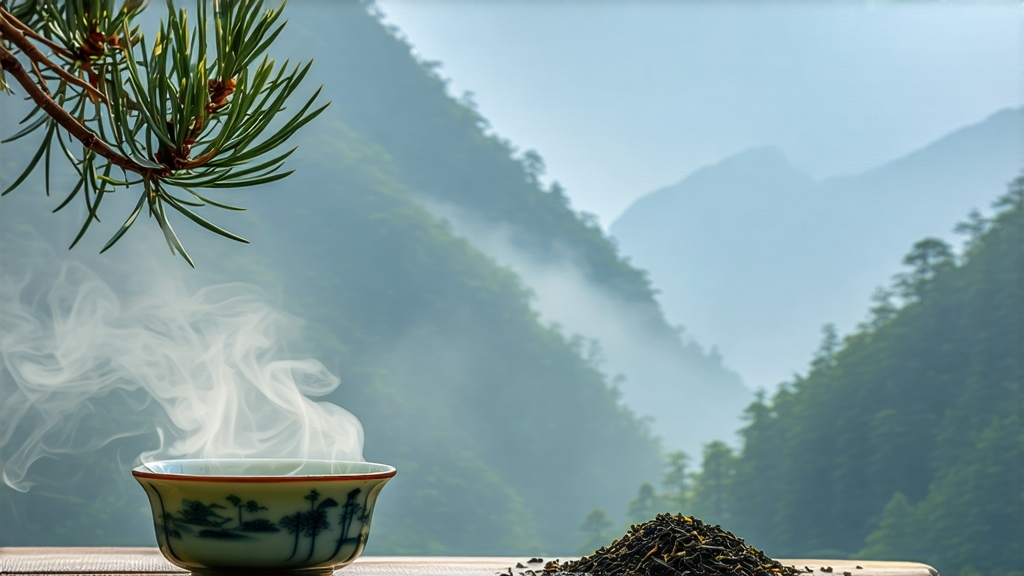
Long before English merchants coined the term “black tea,” the mountain villages of Tongmu in China’s Wuyi range were finishing their spring leaves over smouldering pine boughs. The result—Lapsang Souchong—became the first fully oxidised tea to leave Chinese soil, sailed around the Cape of Good Hope, and filled the porcelain cups of Stuart London. Today it remains the most polarising yet emblematic member of the Chinese red-tea family: a leaf that smells of bacon and birch, night forests and dried longan, yet steeps into a liquor as smooth as Burgundy.
History: From Borderland Tribute to Global Commodity
Tongmu sits in a granite gorge so remote that imperial tax collectors seldom ventured in. During the late Ming, army units passing through commandeered tea baskets for barter. To accelerate drying, villagers threw fresh leaves into charcoal kilns lined with pine resin. The smoky leaf travelled north along the Tea-Horse Road, winning favour with Mongol horsemen who prized its keeping quality. By 1604 Dutch factors in Batavia had shipped it to Europe, where it fetched ten times the price of green tea and inspired the Earl Grey blend. When the East India Company cloned Wuyi bushes in Assam and Ceylon, Lapsang’s bold profile became the template for every breakfast tea now poured from Dublin to Dar es Salaam.
Terroir: Why Only Tongmu Tastes Like Tongmu
The Wuyi Biosphere Reserve rises 2,160 m above sea level; morning fog slows photosynthesis, concentrating amino acids. The soil is a coarse tuff rich in quartz and iron; roots struggle, yielding smaller leaves with higher volatile oils. Crucially, only two hamlets—Xingcun and Miaowan—possess the microclimate cool and humid enough to absorb pine smoke without turning acrid. Move the same bushes five kilometres downhill and the fragrance collapses into generic campfire.
Leaf Grades: Seven Levels of Smoke
- Zhengshan Xiaozhong: the original, smoked for eight hours over 60-year-old Masson pine.
- Wuyi Gongfu: larger leaf, lighter smoke, malty cocoa finish.
- Jin Jun Mei: buds only, zero smoke, honey and peach notes—created in 2005 for the Beijing diplomatic market.
- Smoked Jin Jun Mei: a hybrid, buds given thirty minutes of cool pine aroma.
- Pekoe Souchong: broken leaf, stronger infusion, favoured in Russia for samovars.
- Imperial Grade: hand-sorted one-tip-two-leaves, smoked, then rested in fir barrels for six months.
- Tongmu Old Bush: leaves from 200-year-old trees, unsmoked, mineral depth reminiscent of aged oolong.
Craft: Turning Green into Night
Picking starts at dawn on the first mist-free day after Qingming. Only the apical bud and the first two leaves are plucked; any more and smoke clings harshly. Wilting occurs on bamboo trays set above the pine kilns so that ambient resin pre-scents the leaf. Rolling is done by machine for 70 minutes at 24 °C to rupture 85 % of cell walls without heating enzymes. Oxidation proceeds in cedar-lined chests; every fifteen minutes the tea master lifts a handful to the light, waiting for the copper penny colour that signals 95 % oxidation. The critical smoking stage follows: pinewood is burned down to embers, then damped with wet fir sawdust to create a cool, aromatic smoke (28–32 °C). A bamboo drum tumbles the leaf through the smoke for six to ten hours; too hot and the leaf chars, too cool and mould spores bloom. Finally, the tea is charcoal-baked for ninety seconds at 80 °C to fix the aroma and drop moisture to 3 %.
Chemistry of the Campfire
Gas chromatography reveals twenty-two phenolic volatiles unique to Lapsang. Guaiacol and 4-methylguaiacol deliver the bacon note; syringol supplies the sweet, medicinal lift; creosol anchors the lingering aftertaste. These molecules bond with L-theanine, softening astringency and creating the impression of velvet despite an assertive nose.
Brewing: Gongfu versus Teapot versus Samovar
Gongfu (preferred): 5 g leaf, 100 ml porcelain gaiwan, 95 °C water. R